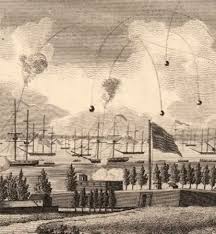The Story Behind the Iconic American Anthem
As the national anthem of the United States, “The Star-Spangled Banner” holds a special place in American culture. It is played before military ceremonies and sports events, becoming an inseparable part of American life. But have you ever wondered who wrote this famous anthem and why it continues to matter today?
Francis Scott Key: The Man Behind the Lyrics
The author of “The Star-Spangled Banner” is Francis Scott Key, a 19th-century lawyer who also had a talent for poetry. Inspired by the events of the Battle of Baltimore in 1814, Key was moved by the American resilience he witnessed. Unable to contain his emotions, he quickly scrawled the lyrics on the back of a letter.
Although the song gained immediate popularity, it took more than a century before it was officially recognized as the national anthem. Since its creation, it has been surrounded by controversy, from its racist undertones to its anti-British sentiments. Furthermore, the melody itself was borrowed from a British tune.
The Creation and Naming of the Anthem
Many Americans have a rather hazy understanding of their national anthem, which is perhaps due to the fact that we usually only sing about a quarter of the entire song. However, the origins and significance of the anthem deserve a thorough examination.
To understand the anthem’s creation, we need to delve into the political context of the time. The War of 1812 was primarily a conflict between the United States and the United Kingdom, with France also playing a significant role. The war erupted due to British interference with American trade and impressment of U.S. sailors into the British Royal Navy.
In September 1814, British forces invaded Washington D.C. and set fire to the White House. They then turned their attention to Baltimore, a crucial seaport. Coincidentally, Francis Scott Key, a Maryland lawyer, found himself negotiating the release of a captured friend in the same harbor where the British were approaching.
While witnessing the British bombardment of Fort McHenry from a ship, Key saw the American flag still flying triumphantly the next morning. Moved by the sight, he hastily finished writing the verses on the back of a letter. At that time, Key actually titled the poem “Defense of Fort M’Henry.”
With the encouragement of his brother-in-law, Joseph Nicholson, a militia commander at the fort, Key’s verses were printed and distributed along with the melody of an English drinking song called “To Anacreon in Heaven” by John Stafford Smith. The poem was soon reprinted by The Baltimore Patriot, gaining recognition across the country. By November, it was renamed “The Star-Spangled Banner.”
From Popular Tune to National Anthem
Although it took over a century for “The Star-Spangled Banner” to become the official national anthem of the United States, it was well-received soon after its publication. Played during various events, the tune captivated the hearts of the American people.
During the Civil War, both sides of the conflict tried to claim the song as their own. The Richmond Examiner declared that it was “Southern in origin, in sentiments, in poetry, and song.” Meanwhile, in the North, physician and poet Oliver Wendell Holmes Sr. added a new stanza emphasizing the freedom gained by “the millions unchained.”
While there was some criticism of the song’s anti-British roots during World War I, it continued to be played at military events by order of President Woodrow Wilson. Efforts were made to find an alternative anthem, but with the song’s performance at the 1918 World Series, “The Star-Spangled Banner” gained even more popularity.
Congressman John Charles Linthicum, a Maryland native, championed the cause of recognizing the song as the national anthem. After presenting a petition with over 5 million signatures in 1930, more than 150 organizations and 25 governors voiced their support. On March 4, 1931, President Herbert Hoover finally declared “The Star-Spangled Banner” the national anthem of the United States.
The Legacy of Francis Scott Key
As with any historical figure, the legacy of Francis Scott Key is complex and multifaceted. While we celebrate his composition of the national anthem, it is important to acknowledge that he was a slaveholder, which has raised questions and criticism. This irony is evident in the lyrics of the song itself, particularly in the line that mentions “the hireling and slave.”
Key’s writings and actions indicate that he opposed the international slave trade and defended enslaved people and free blacks in D.C. courts without charge. However, the ambiguous meaning behind the mentioned line fuels ongoing debates about his intentions.
Despite the controversy, “The Star-Spangled Banner” remains deeply ingrained in American culture and continues to be a symbol of national pride. Whether facing adversity as a nation or celebrating victories, this anthem stands as a testament to the enduring spirit of the American people.
